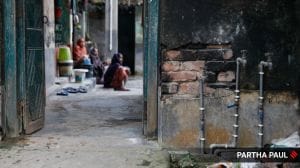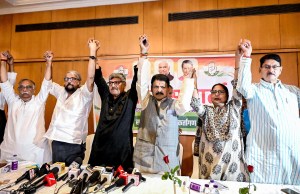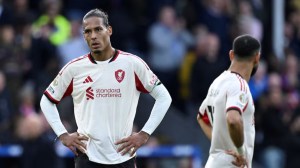Not without my vote
Get ready for old-fashioned politics, as the Big Two battle it out this year

Just a fortnight into the new year, it might seem a little premature to predict what lies ahead. But one thing can be said with a fair degree of certainty. If the last couple of years were dominated by issues of governance — marked by landmark legislations, major foreign policy initiatives, continuation of economic reforms and consolidation of the unique power-sharing arrangement underpinning the UPA alliance — 2007 will see a return to the hurly burly of old-fashioned politics. It is dotted with elections in different parts of the country and nothing stirs even the most somnolent Indian politician more than electoral heat and dust. And nothing has a greater impact on the morale of a political party than victory or defeat at the hustings.
There have been a number of assembly elections since the cataclysmic 2004 Lok Sabha polls but most of them — Bihar, West Bengal, Kerala, Tamil Nadu — did not involve the Big Two of national politics in a significant way. The Congress was expected to lose West Bengal and Kerala and it did. The fight in Bihar was essentially between two regional players. Ditto in Tamil Nadu.
But 2007 is different. Both the Congress and BJP have very high stakes in most of the poll-bound states, and how they fare will substantially impact national politics and set the stage for the general elections scheduled for mid-2009.
The attention of the political class may be fixated on UP, but elections next month to three smaller assemblies are equally important. For one, in all three states — Uttarakhand, Punjab, and Manipur — the Congress is in power. Unlike in UP and Bihar, where the Congress organisation has shrunk to a pathetic shadow of its once formidable self, the party still has grassroots presence in these states.
Even detractors of Amarinder Singh and N.D. Tiwari concede that there has been a lot of developmental work under their rule and while charges of corruption have not been absent, no major scandal has rocked either Punjab or Uttarakhand.
The real problem, Congressmen privately concede, is the rampant infighting in both states. But the Congress High Command has taken a tough line of late. Realising the importance of the election results, Sonia Gandhi has laid down the law to factional heads — unite or perish. The election results will show how far her writ runs. Of course, a defeat can always be attributed to that catch-all excuse — “anti-incumbency” — but it will also be seen as a failure of the central leadership in making the state units fall in line.
These elections are also a mini-referendum of sorts on the Centre’s image and policies. It is commonly believed that both Manmohan Singh and Sonia Gandhi enjoy high popular ratings, greater than when the UPA initially assumed office.
The BJP is directly pitted against the Congress in Uttarakhand and the Akali Dal-BJP alliance is set to give a tough fight in Punjab. For the BJP, buoyant after the good showing in the UP municipal elections, these two states are crucial. If the party manages to win one or both, it would give a big boost to its already inflated hopes of doing much better than expected in UP.
The elections in UP might not throw up a clear winner but it will provide the laboratory for the next stage of coalitional deal-making. Tragically enough, the Congress party did nothing over the last two years to capitalise on the goodwill and nostalgia for the Grand Old Party that was so palpable in the run-up to the 2004 general elections. Congressmen squandered their energies in a futile wait for Rahul ‘Godot’ Gandhi and are now hoping to play a role in forming the next government in Lucknow if they manage a “respectable” 40-odd seats, in a House of 403.
The BJP, on the other hand, is pinning its hopes on the return of the urban middle class and upper castes to its Hindutva fold. If the BJP does manage to better the 89 seats it won last time, it will certainly lead to a new churning in national politics.
The UP elections will be followed by polls in Goa — another state where a Congress government will face a challenge from its national rival BJP — before we witness the mother of all political-cum-ideological contests in Gujarat towards the end of the year. After being almost comatose for years, the Congress has begun to show faint stirrings of life in the state, especially in its erstwhile support base of dalits, adivasis and Muslims. But Narendra Modi, seemingly indomitable with his hyped-up ‘vibrant Gujarat’ campaigns, faces an even bigger challenge from within. His detractors within the BJP and the wider Sangh Parivar are lying low but could make things difficult for him as elections draw near.
In fact, the results of UP and Gujarat are likely to have a major impact on the internal dynamics of the BJP as well. If the BJP does well in UP, Rajnath Singh will emerge as the strongest leader among the GenNext waiting to displace the old guard. But if Narendra Modi manages to repeat his 2002 victory, he could displace Singh as the future supremo of the BJP.
Then there are Jharkhand and Karnataka, where unstable ruling coalitions could well topple some time this year and join the list of poll-bound states. Regional parties apart, the Congress and BJP also have big stakes in Bangalore as much as Ranchi.
And let us not forget that presidential elections are due in a few months’ time. Even if the Congress retains its current tally and improves in UP, it cannot impose its own man in Rashtrapati Bhavan and will have to search for a candidate acceptable to the UPA and the Left or conversely back a non-Congress candidate. Since the days of rubber stamp presidents are over, presidential elections too are fraught with suspense, and sometimes, intrigue.
Middle-class activism via SMS polls may have passed off as new age politics in the year gone by. But as millions in far-flung corners of this vast land make their way to the polling booths this year, it is time to get ready for the real thing.



- 01
- 02
- 03
- 04
- 05




























